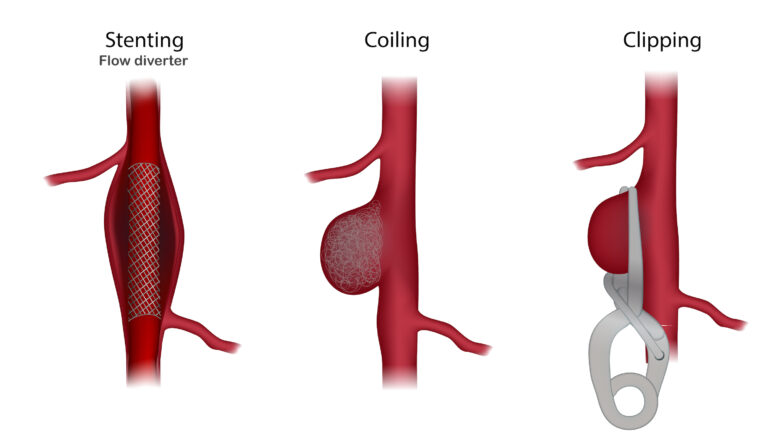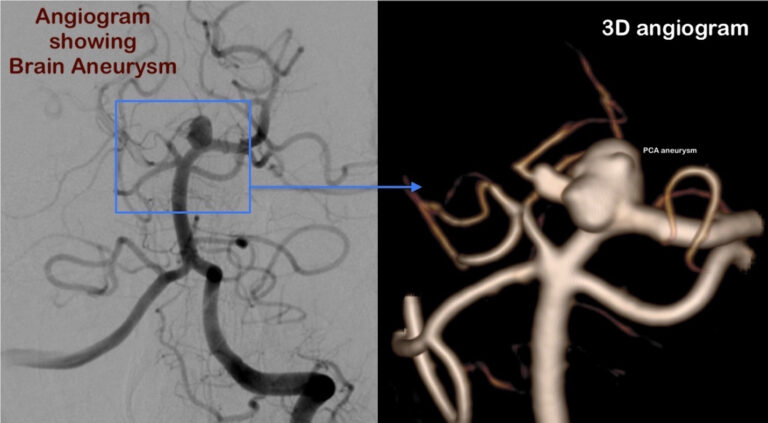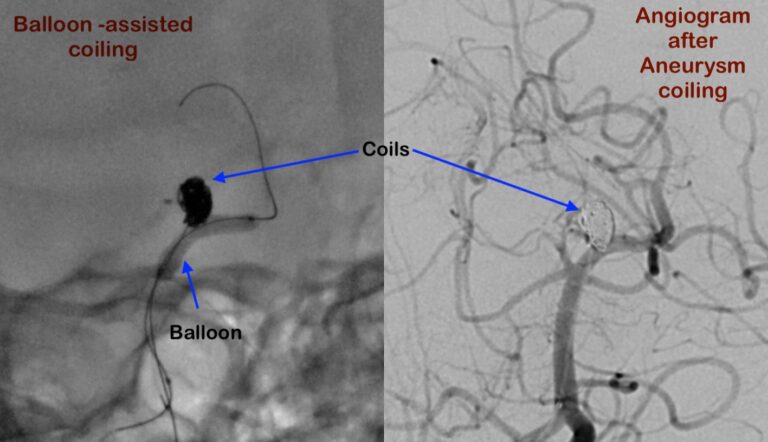Brain aneurysm
1. What is an aneurysm?
‘Aneurysm’ refers to a bulging or ballooning in the wall of a blood vessel. The disease arises due to a weakening in the blood vessel wall. Aneurysms can occur in any blood vessel in the body.

2. What is a Brain aneurysm?
Aneurysms that occur in the blood vessels of the brain are termed ‘Brain aneurysms’. In medical terms, they are called ‘Cerebral aneurysms’ or ‘Intracranial aneurysms’.
3. What are the symptoms of Brain aneurysm?
Brain aneurysms usually do not have any symptoms till they rupture. The most common symptom of aneurysm rupture is headache (Patients describe it as the ‘worst headache’ of their life). Headache may be associated with nausea and vomiting. Other common symptoms include seizures, confused and disoriented behaviour, visual disturbances and neck pain. Some patients lose consciousness and come to the hospital in a comatose
Aneurysm rupture can be life-threatening event. 10% – 30% of patients die within minutes of an aneurysm rupture.
Unruptured aneurysms are usually diagnosed ‘incidentally’ when a brain scan (MRI or CT scan) is done for other purposes like an unrelated headache.
In some situations, unruptured aneurysms can be a cause for headache, seizures, and vision disturbances.
4. Why do some patients develop aneurysms? What are the risk factors of brain aneurysm?
The exact reasons why some people develop brain aneurysms is not clearly known. Some of the risk factors are
- Smoking
- Hypertension
- Family History of brain aneurysm
- Patients suffering from other diseases like Polycystic kidney diseases and certain medical syndromes (Marfans syndrome, Ehlers-Danlos syndrome).
- Some blood infections (‘mycotic’ aneurysms)
5. What problems can arise when a brain aneurysm bursts (ruptures)?
When aneurysm ruptures, bleeding occurs into the space immediately surrounding the brain (to produce ‘Subarachnoid haemorrhage’). Rarely, bleeding may occur into the brain (Intracerebral or intraventricular haemorrhage). The bleeding can cause a wide-spectrum of clinical symptoms ranging from mild headache to permanent brain damage, and at times, death. 10-30% of patients with aneurysm rupture die even before reaching the hospital. Only 30% of patients have a good outcome after ruptured aneurysm treatment. The usual problems encountered during ruptured aneurysm treatment are
Aneurysm rebleed – 20% – 50% are at risk for a second rupture in the initial two weeks.
6. What are the problems of unruptured brain aneurysm?
For an unruptured cerebral aneurysm, the risk of rupture is 1% to 2% per year.
7. How is a brain aneurysm diagnosed?
Imaging of the blood vessels of the brain is called cerebral angiography (‘Cerebral’ referring to ‘Brain’; ‘Angiography’ referring to ‘Imaging of blood vessels’).
Cerebral angiography can be done using CT scan, MRI or with Catheter angiography (DSA, Digital subtraction angiography).
A brain aneurysm can be diagnosed using one of the three techniques. DSA is the best tool to diagnose a Brain aneurysm.
8. What is a Cerebral digital subtraction angiography (DSA)? How is it performed?

A Cerebral DSA is a test performed in a Cath lab (‘Angiosuite’) which shows the blood vessels with utmost clarity. It is done by injecting ‘contrast’ (the dye which highlights the blood vessels) directly into the blood vessels supplying the brain (Carotid and vertebral arteries). This is achieved by passing a thin tube called a ‘catheter’ through the upper thigh or through the wrist and advancing it into the brain-supplying arteries. The procedure typically lasts around 20-30 minutes and is performed under local anaesthesia in most patients. 2D and 3D images can be obtained using DSA.
9. Should brain aneurysms be treated?
Ruptured aneurysm
Of patients with aneurysms rupture, approximately 20% – 50% are at risk for a second rupture in the initial two weeks. This re-bleed event can, as expected, be associated with life-threatening consequences. So treating a ruptured aneurysm as early as possible can be a life-saving procedure.
Unruptured aneurysm
When unruptured aneurysm present with symptoms, the treatment will be tailored according to the symptoms. Discussing with the treating doctor regarding the possible benefits and risks of treatment in relation to the symptoms will be critical in decision making.
When unruptured brain aneurysms are incidentally detected, the biggest concern for both the patient and the treating doctor is if the aneurysm will rupture in the future. Treatment options include close follow-up or active interventional/surgical treatment (see below). A detailed discussion between the doctor and the patient about the treatment options and the risks vs benefits of each option can help in guiding future treatment.
10. How can brain aneurysms be treated?
Brain aneurysms can be treated by two methods
Endovascular (Interventional) methods – In this minimally-invasive treatment, the aneurysm is reached from within the blood vessel by passing thin tubes (called catheters and micro-catheters) and treated by using specialised devices (Coils or flow diverters).
Surgical method (Clipping)– In this treatment, a portion of the skull is removed to gain access to the aneurysm and a clip is placed to protect the aneurysm.

11. Which treatment option is better? Interventional or Open neurosurgery?
Endovascular (Interventional) and Surgical treatment methods play a complementary role to each other. Some aneurysms can be better treated using the Endovascular techniques; and for some aneurysms, open surgery offers better solutions. Enquiring with the treating physicians about both options can help in making a studied decision.
12. What are the most common interventional (endovascular) methods to treat brain aneurysms?
There are two main endovascular treatment options – Coiling and Flow diverter.
Coiling – as the name suggests, small metal coils (made of platinum) are placed carefully within the aneurysm using the guidance of specialised x-rays. Stents and/or balloons may be used as additional tools to facilitate safe placement of coils within the aneurysm. Once safely placed, these coils prevent the impact of flowing blood on the weak aneurysm wall, thereby preventing a rupture.
Flow diverter – Flow diverter is a specialised stent deployed across the aneurysm neck (as depicted in Figure). The flow diverter stents have a very fine mesh. Initially, the flow diverter allows blood to flow through its fine meshes into the aneurysm, albeit rather slowly. However, with time, the slow turbulent flow within the aneurysm promotes the formation of clot (‘thrombus’) thereby occluding the aneurysm.
Aneurysm coiling - Case illustration


